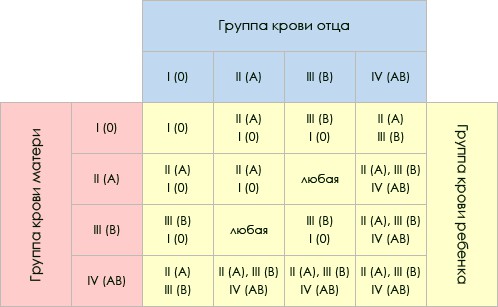What type of blood does the child have: how to determine? table

As you know, there are 4 blood groups. The blood group is inherited genetically, that is, the blood type of the child depends on the blood type of the parents. How to determine which blood type a child will have?
Of course, the most reliable way learn your baby's blood type - do itanalysis. By the results of the analysis, you will know both the blood group and the Rh factor. But if you want you can "estimate" the blood group of the child even before his birth, knowing the blood groups of his parents.
The system of blood grouping, which is generally accepted at the present time, is called system AB0. According to this system, red blood cells(erythrocytes) of a person are characterized by the presence in them of special substances - antigens. The interaction of antigens influences, in particular, the compatibility of different blood groups in donors and recipients.
There are two categories of antigens - A and B. Two types of antigens, one or none, can be contained in a person's blood. Depending on this, the four blood groups:
I (0) - both antigens are absent
II (A) - there is antigen A
III (B) - there is antigen B
IV (AB) - both antigens are present
But how can this information help determine which blood type a child has? The fact is that inheritance of the blood group occurs in the same way as the inheritance of other traits (for example, the color of eyes and hair) and obeysthe laws of genetics formulated by Mendel. Of course, these laws will not help to determine with 100% certainty what type of blood the child has, but a certain pattern can be traced:
At parents with I group of blood children with I group of blood are born.
Parents with group II blood are born with children with I or II blood group.
At parents with III group of blood children with I or III blood type are born.
Parents with I and II or I and III have children with one of these blood groups.
If one of the parents has group IV blood, then the child can not have I blood type.
If one of the parents has group I blood, then they can not have a child with group IV blood.
Parents with blood groups II and III may have children with any blood type.
For more visibility we offer you small table. In it, you can see what type of blood can be in a child with a certain combination of blood groups of parents.
Table of inheritance of blood groups

In addition to the blood group, it is important to know her rhesus factor. The Rhesus of the blood is on the surfaceerythrocyte protein (antigen). This protein is in most people, so they are considered Rh positive. Those who do not have this protein (and only about 15% of such people) are considered Rh negative.
Many people mistakenly believe that Rh-positive parents can only have a Rh-positive baby. In fact, this is not so. The fact is that negative Rhesus is a recessive, "weak" sign. This sign can be present in the genotype, but "suppressed" by a stronger sign-the dominant one.
If both parents have both a dominant and a recessive sign in the genotype of both parents, then both will have a positive rhesus, but there is 25% chance that their child will be Rhesus negative as a result of a combination of two recessive traits.
Thus, if both parents or at leastone of them has a positive Rh factor, then a Rh-positive and a Rh-negative child can be born. The same applies to couples in which one parent is Rh-positive, and the second-Rh-negative. In two parents with a negative Rh factor, only a Rh-negative child can be born.
As you can see, the basic knowledge of genetics at the level of the school curriculum may well help to determine which blood type a child has, at least approximately. And if you do not want to remember, you help our plate.














